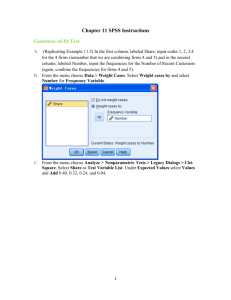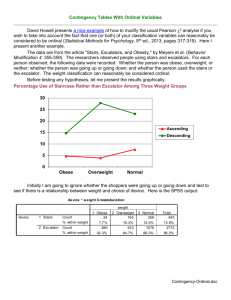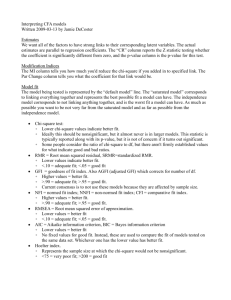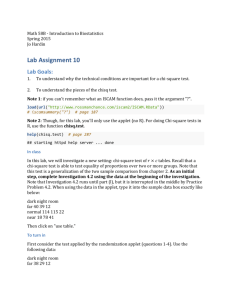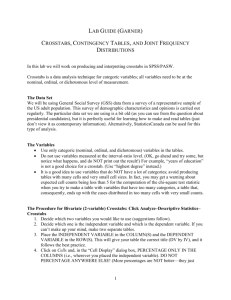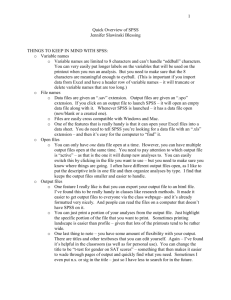Data Analysis (SPSS) manual
advertisement
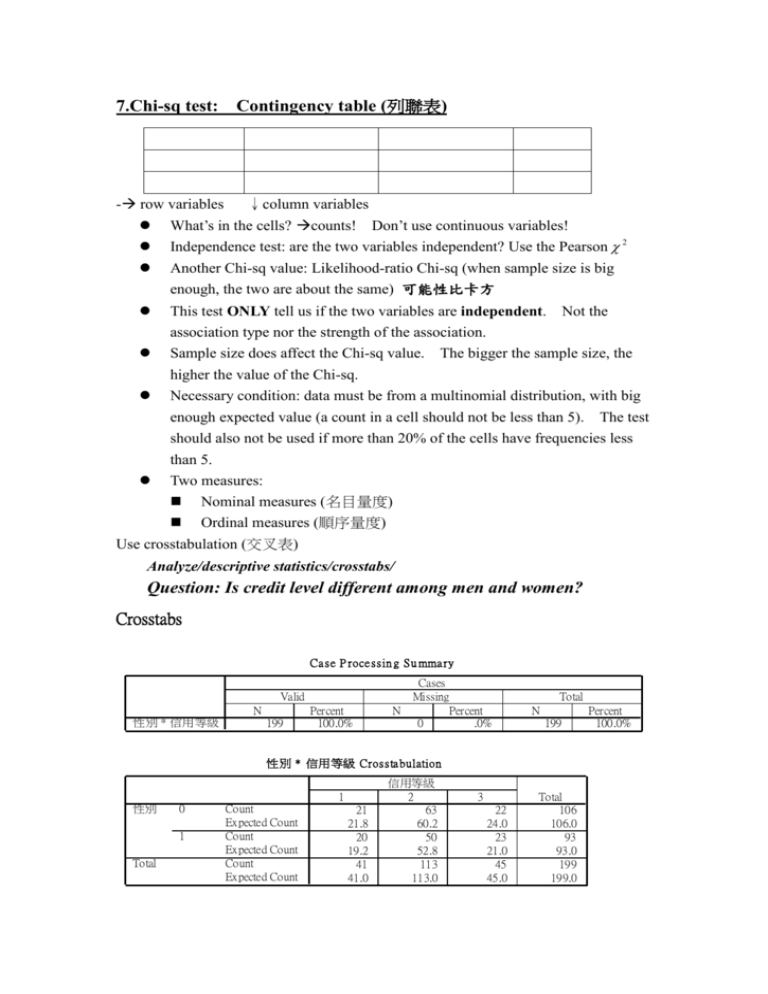
7.Chi-sq test: Contingency table (列聯表) - row variables ↓column variables What’s in the cells? counts! Don’t use continuous variables! Independence test: are the two variables independent? Use the Pearson 2 Another Chi-sq value: Likelihood-ratio Chi-sq (when sample size is big enough, the two are about the same) 可能性比卡方 This test ONLY tell us if the two variables are independent. Not the association type nor the strength of the association. Sample size does affect the Chi-sq value. The bigger the sample size, the higher the value of the Chi-sq. Necessary condition: data must be from a multinomial distribution, with big enough expected value (a count in a cell should not be less than 5). The test should also not be used if more than 20% of the cells have frequencies less than 5. Two measures: Nominal measures (名目量度) Ordinal measures (順序量度) Use crosstabulation (交叉表) Analyze/descriptive statistics/crosstabs/ Question: Is credit level different among men and women? Crosstabs Ca se P roce ssin g Su mma ry Valid N 性別 * 信用等級 199 Percent 100.0% N Cases Missing Percent 0 .0% Total N 199 性別 * 信用等級 Crossta bulation 1 性別 0 1 Total Count Expected Count Count Expected Count Count Expected Count 21 21.8 20 19.2 41 41.0 信用等級 2 63 60.2 50 52.8 113 113.0 3 22 24.0 23 21.0 45 45.0 Total 106 106.0 93 93.0 199 199.0 Percent 100.0% Ch i-Sq uare Te sts Asymp. Sig. Value df (2-sided) Pearson Chi-Square .696a 2 .706 Likelihood Ratio .696 2 .706 Linear-by-Linear Association .059 1 .807 N of Valid Cases 199 a. 0 cells (.0%) have expected count less than 5. The minimum expected count is 19.16. Symmetric Measures Value Nominal by Nominal Contingency Coefficient Approx. Sig. .059 N of Valid Cases .706 199 a Not assuming the null hypothesis. b Using the asymptotic standard error assuming the null hypothesis. If choose “surpress table”, no table will be printed. Question: Can we separate a continuous variable to discrete ranges and compare? Transform/categorize variables/ 4 group Result: 性別 * NTILES of 所得 Crosstabulation Count NTILES of 所得 1 性別 2 3 4 Total 0 30 37 18 21 106 1 19 13 32 29 93 49 50 50 50 199 Total Chi-Square Tests Asymp. Sig. Value Pearson Chi-Square Likelihood Ratio Linear-by-Linear Association N of Valid Cases df (2-sided) 18.419(a) 3 .000 18.908 3 .000 9.138 1 .003 199 a 0 cells (.0%) have expected count less than 5. The minimum expected count is 22.90. Does the result make sense? NO!!!! Ex. Grade data 1. 2. 3. 4. Try sex distribution in different departments? Try Sex and living areas? Try living areas vs. departments? Try admission type and departments? Different? **Try to convert the cross tables to the following inputs. Data input: Use Data/Weight cases/ to give replicated frequencies Then use Analyze/Nonparametric tests/Chi-square/ 1. 適合度檢定 (test of goodness of fit) to see if the observed frequencies is as expected ex. 280 kids were tested for attractiveness of colors color A COUNT 52 B C D E F G 48 44 31 29 30 46 Use Weight cases to assign the counts to Freq. var. 色紙 Observed N Expected N Residual 紅 52 40.0 12.0 橙 48 40.0 8.0 黃 44 40.0 4.0 綠 31 40.0 -9.0 藍 29 40.0 -11.0 靛 30 40.0 -10.0 紫 46 40.0 6.0 Total 280 Test Statistics 色紙 Chi-Square(a) df Asymp. Sig. 14.050 6 .029 a 0 cells (.0%) have expected frequencies less than 5. The minimum expected cell frequency is 40.0. Reject Null. The attractiveness is different. 2. Test of homogeneity proportions – to see if the responses from several populations are different (usually an (IXJ) contingency table) Ex. The three grades of high schools were tested for whether they wore glasses 1st 2nd 3rd Yes 27 34 28 No 15 12 9 Level Grade Freq 1 1 1 27 2 2 1 15 3 1 2 34 4 2 2 12 5 1 3 28 6 2 3 9 Data input Weight cases freq Analyze/descriptive/crosstabs Choose Chi-sq value row: yes, no; column: grade 有無經驗 * 年級 Crosstabulation Count 年級 國一 國二 國三 Total 有無經 有 27 34 28 89 驗 無 15 12 9 36 42 46 37 125 Total Chi-Square Tests Asymp. Sig. Value Pearson Chi-Square df (2-sided) 1.506(a) 2 .471 Likelihood Ratio 1.481 2 .477 Linear-by-Linear Association 1.277 1 .259 N of Valid Cases 125 a 0 cells (.0%) have expected count less than 5. The minimum expected count is 10.66. Can’t reject Null: No difference. 3. test of independence (or test of association) – to see if several independent variables are related Ex. Is education related to brand loyalty? education brand loyalty low medium high University 6 17 20 High school 15 26 24 Junior high 31 34 13 Elementary school 42 45 10 Data input education loyalty freq 1 1 1 6 2 1 2 17 3 1 3 20 4 2 1 15 5 2 2 26 6 2 3 24 7 3 1 31 8 3 2 34 9 3 3 13 10 4 1 42 11 4 2 45 12 4 3 10 row: education; column: loyalty weight cases: freq crosstabs: 教育程度 * 社經地位 Crosst abulation Count 低 教育 程度 Total 大學 高中 國中 國小 6 15 31 42 94 社經地位 中 17 26 34 45 122 高 Total 20 24 13 10 67 43 65 78 97 283 Ch i-Sq uare Te sts Asymp. Sig. Value df (2-sided) Pearson Chi-Square 34.533a 6 .000 Likelihood Ratio 35.172 6 .000 Linear-by-Linear Association 30.237 1 .000 N of Valid Cases 283 a. 0 cells (.0%) have expected count less than 5. The minimum expected count is 10.18. Reject Null: education is related to brand loyalty. How are they related? Directional Measures Value Nominal by Nominal Lambda Symmetric 教育程度 Dependent 社經地位 Dependent Goodman and 教育程度 Kruskal tau Dependent 社經地位 Dependent Uncertainty Symmetric Coefficient 教育程度 Dependent 社經地位 Dependent Asymp. Std. Approx. Error(a) T(b) .049 .023 2.032 .042 .075 .030 2.426 .015 .019 .037 .493 .622 .039 .012 .000(c) .051 .016 .000(c) .051 .017 3.097 .000(d) .046 .015 3.097 .000(d) .058 .019 3.097 .000(d) a Not assuming the null hypothesis. b Using the asymptotic standard error assuming the null hypothesis. c Based on chi-square approximation d Likelihood ratio chi-square probability. Symmetric Measures Value Approx. Sig. Approx. Sig. Phi .349 .000 Cramer's V .247 .000 Contingency .330 Coefficient N of Valid Cases .000 283 a Not assuming the null hypothesis. b Using the asymptotic standard error assuming the null hypothesis. Note: Phi is only for 2X2 variables Note: Contingency coeff: 2X2 or more Note: Cramer’s V: when I is not equal to J 4. test of significance of change: to see if there is any before-and-after changes Ex. Do you like this class: after before yes no Yes 9 28 no 24 19 Data input 1 1 2 2 1 2 1 2 28 9 19 24 weight cases: freq. Analyze/nonparametric tests/2 related samples/ Since we have a 2X2, choose McNemar test 學期初 & 學期末 學期末 學期初 1 2 1 28 9 2 19 24 Test Statistics(b) 學期初 & 學期末 N Chi-Square(a) Asymp. Sig. a Continuity Corrected 80 2.893 .089 b McNemar Test Fail to reject Null: Their attitude does not change. If your data are binary, use the McNemar test. This test is typically used in a repeated measures situation, in which each subject's response is elicited twice, once before and once after a specified event occurs. The McNemar test determines whether the initial response rate (before the event) equals the final response rate (after the event). This test is useful for detecting changes in responses due to experimental intervention in before-and-after designs. If your data are categorical, use the marginal homogeneity test. This is an extension of the McNemar test from binary response to multinomial response. It tests for changes in response using the chi-square distribution and is useful for detecting response changes due to experimental intervention in before-and-after designs. The marginal homogeneity test is available only if you have installed Exact Tests.
